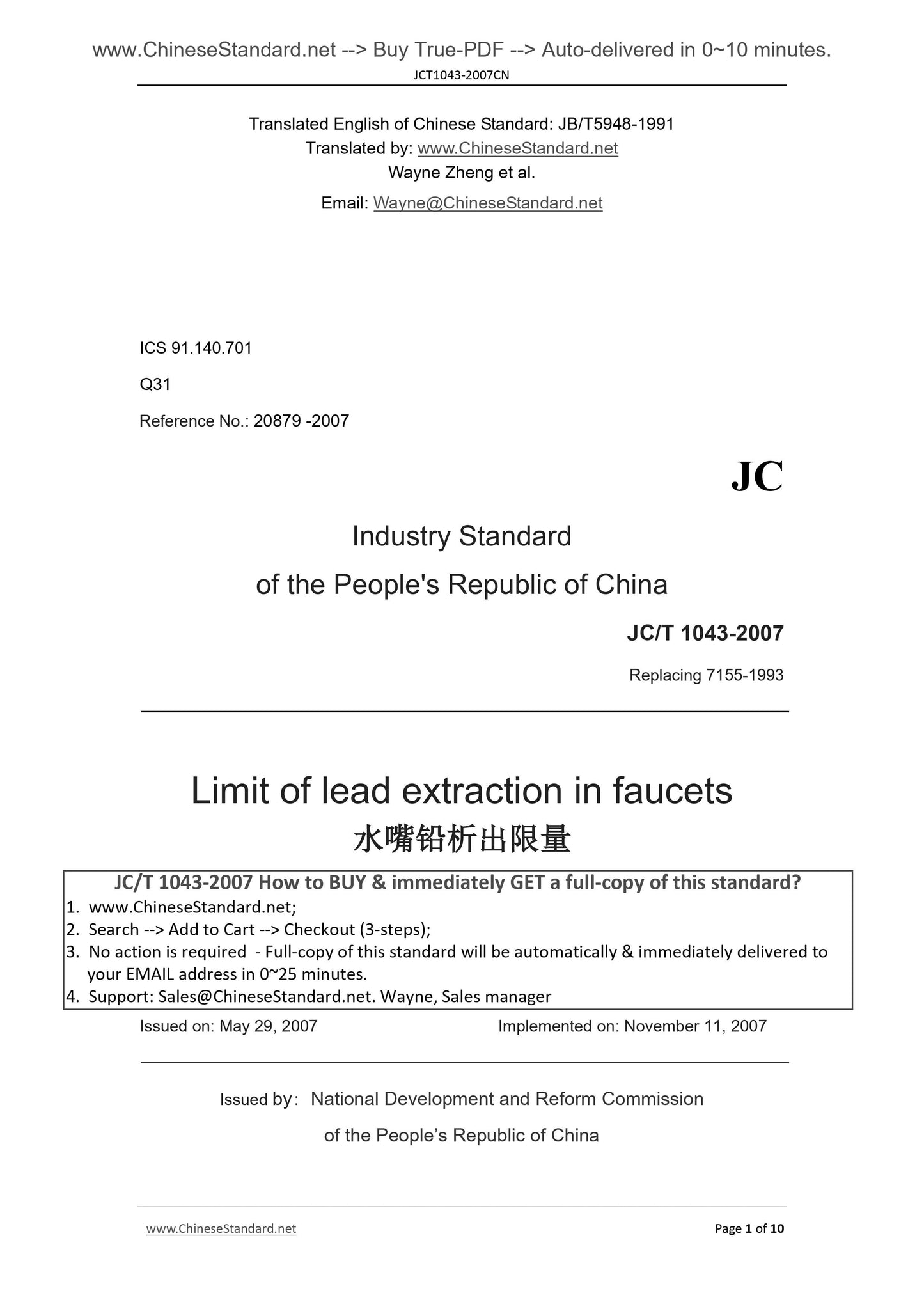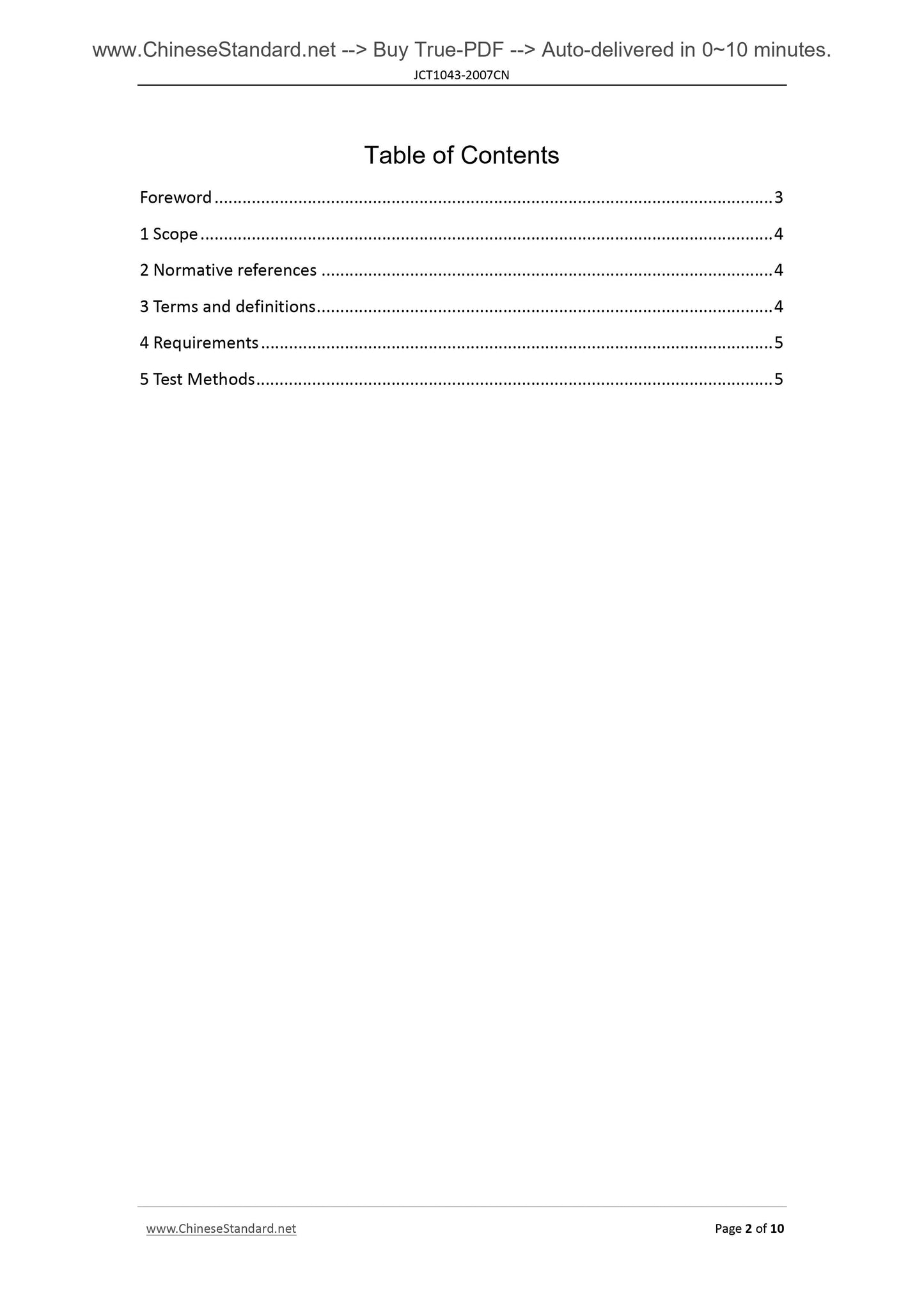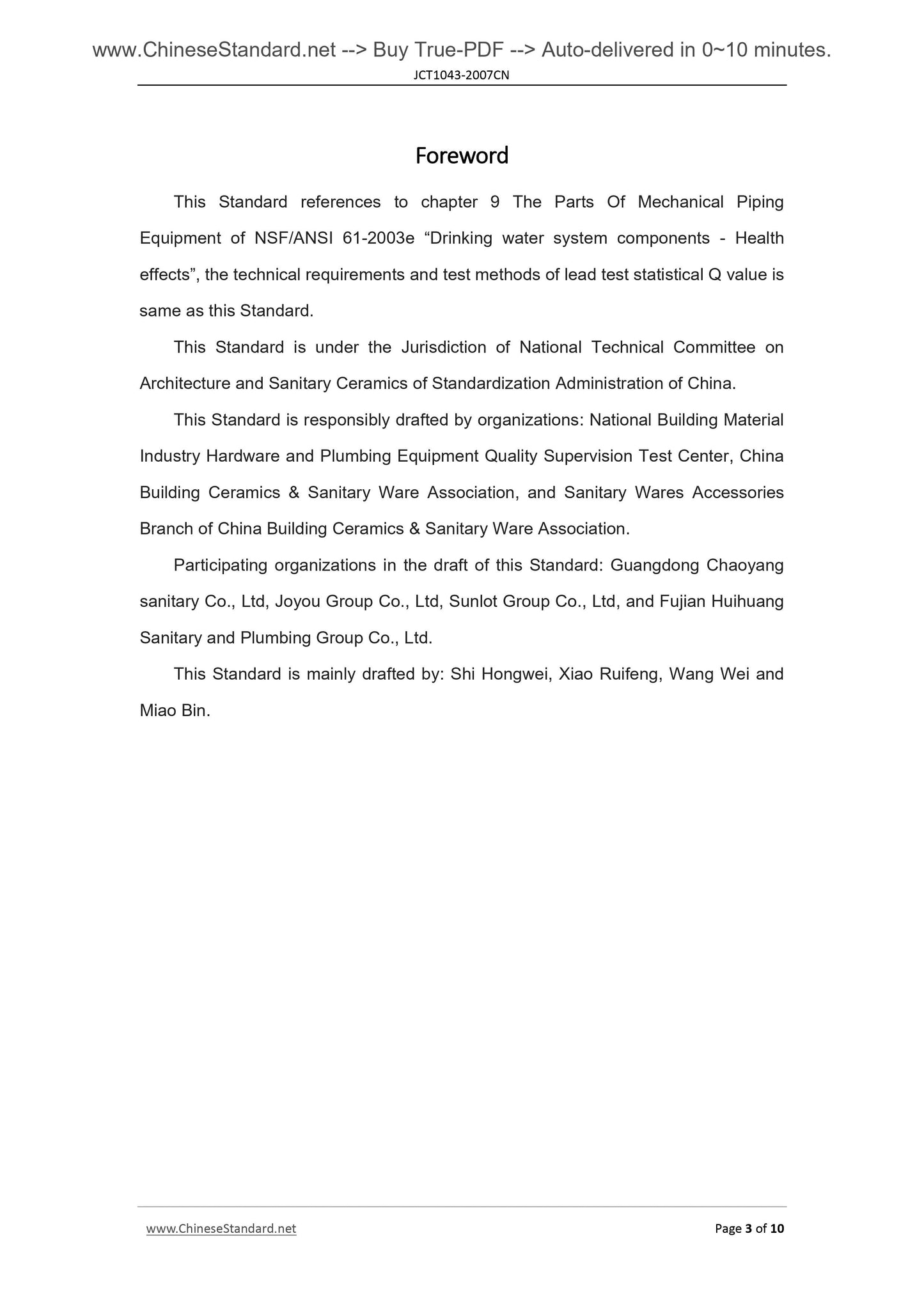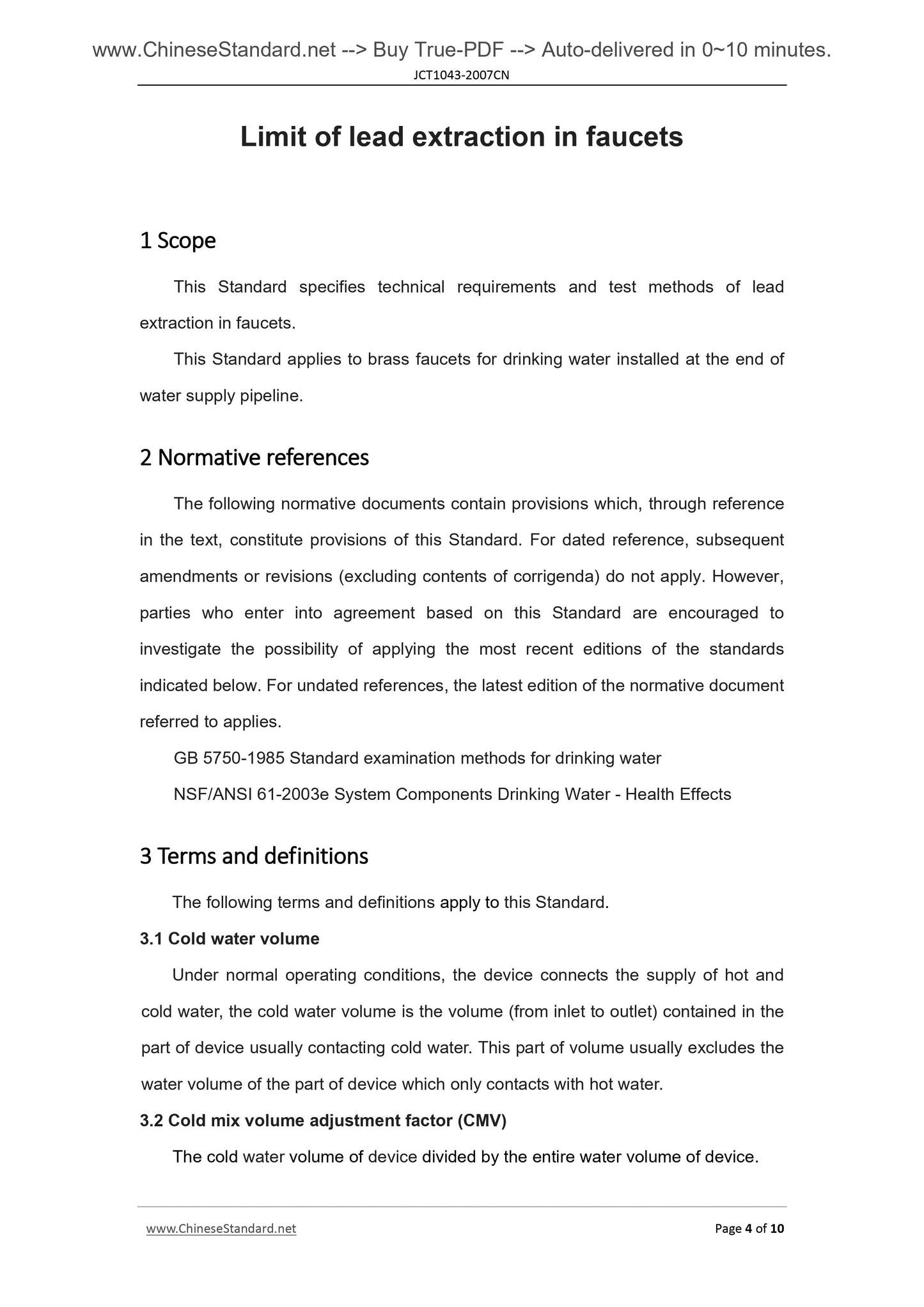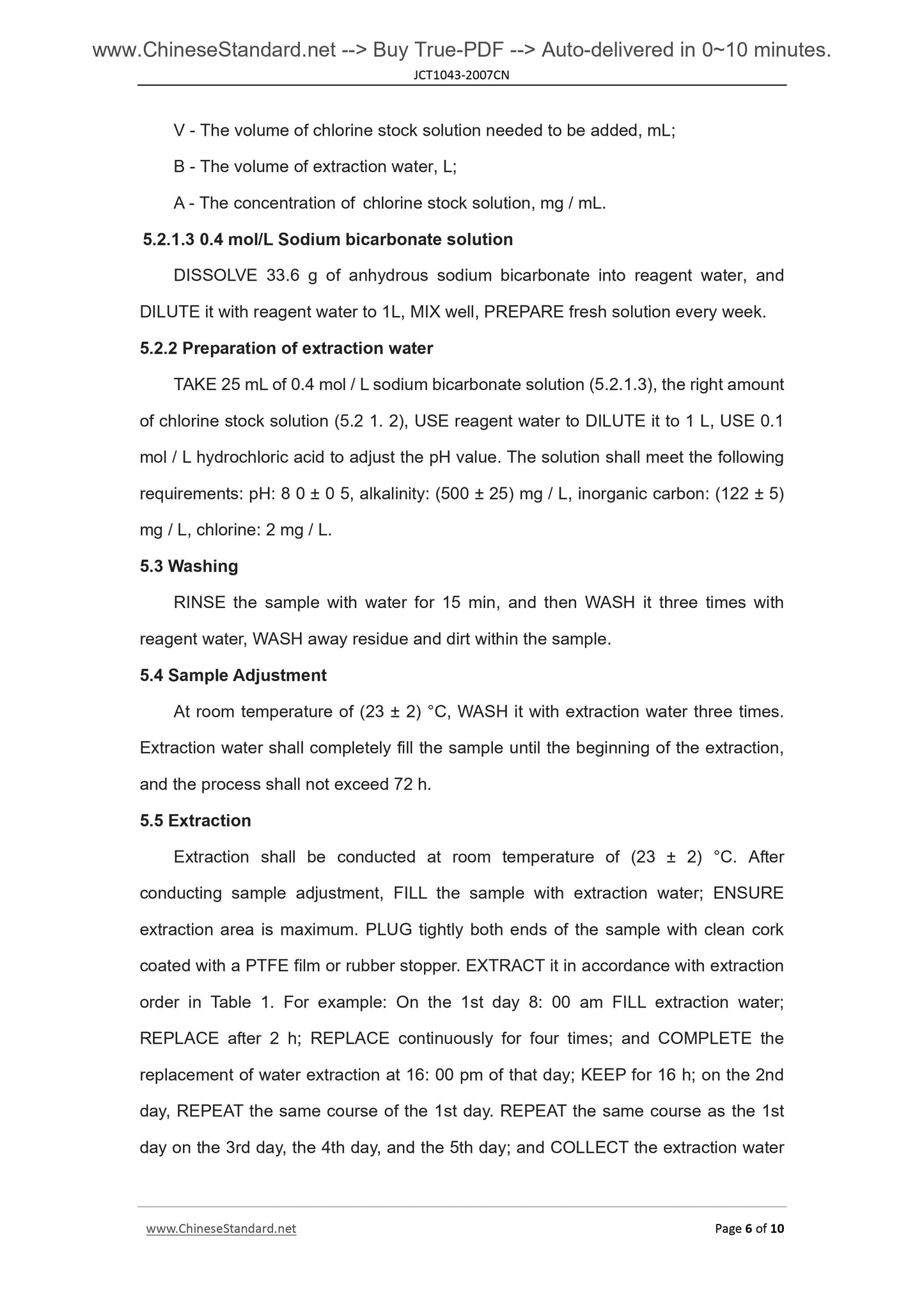1
/
of
5
PayPal, credit cards. Download editable-PDF and invoice in 1 second!
JC/T 1043-2007 English PDF (JCT1043-2007)
JC/T 1043-2007 English PDF (JCT1043-2007)
Regular price
$110.00 USD
Regular price
Sale price
$110.00 USD
Unit price
/
per
Shipping calculated at checkout.
Couldn't load pickup availability
Delivery: 3 seconds. Download true-PDF + Invoice.
Get QUOTATION in 1-minute: Click JC/T 1043-2007
Historical versions: JC/T 1043-2007
Preview True-PDF (Reload/Scroll if blank)
JC/T 1043-2007: Limit of lead extraction in faucets
JCT1043-2007CN
ICS 91.140.701
Q31
Reference No.. 20879 -2007
JC
Industry Standard
of the People's Republic of China
Replacing 7155-1993
Limit of lead extraction in faucets
ISSUED ON. MAY 29, 2007
IMPLEMENTED ON. NOVEMBER 11, 2007
Issued by. National Development and Reform Commission
of the People’s Republic of China
Table of Contents
Foreword ... 3
1 Scope ... 4
2 Normative references ... 4
3 Terms and definitions ... 4
4 Requirements ... 5
5 Test Methods ... 5
Foreword
This Standard references to chapter 9 The Parts Of Mechanical Piping
Equipment of NSF/ANSI 61-2003e “Drinking water system components - Health
effects”, the technical requirements and test methods of lead test statistical Q value is
same as this Standard.
This Standard is under the Jurisdiction of National Technical Committee on
Architecture and Sanitary Ceramics of Standardization Administration of China.
This Standard is responsibly drafted by organizations. National Building Material
Industry Hardware and Plumbing Equipment Quality Supervision Test Center, China
Building Ceramics and Sanitary Ware Association, and Sanitary Wares Accessories
Branch of China Building Ceramics and Sanitary Ware Association.
Participating organizations in the draft of this Standard. Guangdong Chaoyang
sanitary Co., Ltd, Joyou Group Co., Ltd, Sunlot Group Co., Ltd, and Fujian Huihuang
Sanitary and Plumbing Group Co., Ltd.
This Standard is mainly drafted by. Shi Hongwei, Xiao Ruifeng, Wang Wei and
Miao Bin.
Limit of lead extraction in faucets
1 Scope
This Standard specifies technical requirements and test methods of lead
extraction in faucets.
This Standard applies to brass faucets for drinking water installed at the end of
water supply pipeline.
2 Normative references
The following normative documents contain provisions which, through reference
in the text, constitute provisions of this Standard. For dated reference, subsequent
amendments or revisions (excluding contents of corrigenda) do not apply. However,
parties who enter into agreement based on this Standard are encouraged to
investigate the possibility of applying the most recent editions of the standards
indicated below. For undated references, the latest edition of the normative document
referred to applies.
GB 5750-1985 Standard examination methods for drinking water
NSF/ANSI 61-2003e System Components Drinking Water - Health Effects
3 Terms and definitions
The following terms and definitions apply to this Standard.
3.1 Cold water volume
Under normal operating conditions, the device connects the supply of hot and
cold water, the cold water volume is the volume (from inlet to outlet) contained in the
part of device usually contacting cold water. This part of volume usually excludes the
water volume of the part of device which only contacts with hot water.
3.2 Cold mix volume adjustment factor (CMV)
The cold water volume of device divided by the entire water volume of device.
V - The volume of chlorine stock solution needed to be added, mL;
B - The volume of extraction water, L;
A - The concentration of chlorine stock solution, mg / mL.
5.2.1.3 0.4 mol/L Sodium bicarbonate solution
DISSOLVE 33.6 g of anhydrous sodium bicarbonate into reagent water, and
DILUTE it with reagent water to 1L, MIX well, PREPARE fresh solution every week.
5.2.2 Preparation of extraction water
TAKE 25 mL of 0.4 mol / L sodium bicarbonate solution (5.2.1.3), the right amount
of chlorine stock solution (5.2 1. 2), USE reagent water to DILUTE it to 1 L, USE 0.1
mol / L hydrochloric acid to adjust the pH value. The solution shall meet the following
requirements. pH. 8 0 ± 0 5, alkalinity. (500 ± 25) mg / L, inorganic carbon. (122 ± 5)
mg / L, chlorine. 2 mg / L.
5.3 Washing
RINSE the sample with water for 15 min, and then WASH it three times with
reagent water, WASH away residue and dirt within the sample.
5.4 Sample Adjustment
At room temperature of (23 ± 2) °C, WASH it with extraction water three times.
Extraction water shall completely fill the sample until the beginning of the extraction,
and the process shall not exceed 72 h.
5.5 Extraction
Extraction shall be conducted at room temperature of (23 ± 2) °C. After
conducting sample adjustment, FILL the sample with extraction water; ENSURE
extraction area is maximum. PLUG tightly both ends of the sample with clean cork
coated with a PTFE film or rubber stopper. EXTRACT it in accordance with extraction
order in Table 1. For example. On the 1st day 8. 00 am FILL extraction water;
REPLACE after 2 h; REPLACE continuously for four times; and COMPLETE the
replacement of water extraction at 16. 00 pm of that day; KEEP for 16 h; on the 2nd
day, REPEAT the same course of the 1st day. REPEAT the same course as the 1st
day on the 3rd day, the 4th day, and the 5th day; and COLLECT the extraction water
Get QUOTATION in 1-minute: Click JC/T 1043-2007
Historical versions: JC/T 1043-2007
Preview True-PDF (Reload/Scroll if blank)
JC/T 1043-2007: Limit of lead extraction in faucets
JCT1043-2007CN
ICS 91.140.701
Q31
Reference No.. 20879 -2007
JC
Industry Standard
of the People's Republic of China
Replacing 7155-1993
Limit of lead extraction in faucets
ISSUED ON. MAY 29, 2007
IMPLEMENTED ON. NOVEMBER 11, 2007
Issued by. National Development and Reform Commission
of the People’s Republic of China
Table of Contents
Foreword ... 3
1 Scope ... 4
2 Normative references ... 4
3 Terms and definitions ... 4
4 Requirements ... 5
5 Test Methods ... 5
Foreword
This Standard references to chapter 9 The Parts Of Mechanical Piping
Equipment of NSF/ANSI 61-2003e “Drinking water system components - Health
effects”, the technical requirements and test methods of lead test statistical Q value is
same as this Standard.
This Standard is under the Jurisdiction of National Technical Committee on
Architecture and Sanitary Ceramics of Standardization Administration of China.
This Standard is responsibly drafted by organizations. National Building Material
Industry Hardware and Plumbing Equipment Quality Supervision Test Center, China
Building Ceramics and Sanitary Ware Association, and Sanitary Wares Accessories
Branch of China Building Ceramics and Sanitary Ware Association.
Participating organizations in the draft of this Standard. Guangdong Chaoyang
sanitary Co., Ltd, Joyou Group Co., Ltd, Sunlot Group Co., Ltd, and Fujian Huihuang
Sanitary and Plumbing Group Co., Ltd.
This Standard is mainly drafted by. Shi Hongwei, Xiao Ruifeng, Wang Wei and
Miao Bin.
Limit of lead extraction in faucets
1 Scope
This Standard specifies technical requirements and test methods of lead
extraction in faucets.
This Standard applies to brass faucets for drinking water installed at the end of
water supply pipeline.
2 Normative references
The following normative documents contain provisions which, through reference
in the text, constitute provisions of this Standard. For dated reference, subsequent
amendments or revisions (excluding contents of corrigenda) do not apply. However,
parties who enter into agreement based on this Standard are encouraged to
investigate the possibility of applying the most recent editions of the standards
indicated below. For undated references, the latest edition of the normative document
referred to applies.
GB 5750-1985 Standard examination methods for drinking water
NSF/ANSI 61-2003e System Components Drinking Water - Health Effects
3 Terms and definitions
The following terms and definitions apply to this Standard.
3.1 Cold water volume
Under normal operating conditions, the device connects the supply of hot and
cold water, the cold water volume is the volume (from inlet to outlet) contained in the
part of device usually contacting cold water. This part of volume usually excludes the
water volume of the part of device which only contacts with hot water.
3.2 Cold mix volume adjustment factor (CMV)
The cold water volume of device divided by the entire water volume of device.
V - The volume of chlorine stock solution needed to be added, mL;
B - The volume of extraction water, L;
A - The concentration of chlorine stock solution, mg / mL.
5.2.1.3 0.4 mol/L Sodium bicarbonate solution
DISSOLVE 33.6 g of anhydrous sodium bicarbonate into reagent water, and
DILUTE it with reagent water to 1L, MIX well, PREPARE fresh solution every week.
5.2.2 Preparation of extraction water
TAKE 25 mL of 0.4 mol / L sodium bicarbonate solution (5.2.1.3), the right amount
of chlorine stock solution (5.2 1. 2), USE reagent water to DILUTE it to 1 L, USE 0.1
mol / L hydrochloric acid to adjust the pH value. The solution shall meet the following
requirements. pH. 8 0 ± 0 5, alkalinity. (500 ± 25) mg / L, inorganic carbon. (122 ± 5)
mg / L, chlorine. 2 mg / L.
5.3 Washing
RINSE the sample with water for 15 min, and then WASH it three times with
reagent water, WASH away residue and dirt within the sample.
5.4 Sample Adjustment
At room temperature of (23 ± 2) °C, WASH it with extraction water three times.
Extraction water shall completely fill the sample until the beginning of the extraction,
and the process shall not exceed 72 h.
5.5 Extraction
Extraction shall be conducted at room temperature of (23 ± 2) °C. After
conducting sample adjustment, FILL the sample with extraction water; ENSURE
extraction area is maximum. PLUG tightly both ends of the sample with clean cork
coated with a PTFE film or rubber stopper. EXTRACT it in accordance with extraction
order in Table 1. For example. On the 1st day 8. 00 am FILL extraction water;
REPLACE after 2 h; REPLACE continuously for four times; and COMPLETE the
replacement of water extraction at 16. 00 pm of that day; KEEP for 16 h; on the 2nd
day, REPEAT the same course of the 1st day. REPEAT the same course as the 1st
day on the 3rd day, the 4th day, and the 5th day; and COLLECT the extraction water
Share
